It's the most photogenic field in sports. With its diamond grass stage and mound dirt spotlight, baseball is a small-screen dream. This season, television directors of Major League Baseball's best games made that stage shine. From no-hitters to the World Series, from an All-Star showcase to an all-time save leader's farewell, the technical and artistic choices made by the directors of those games shaped how we viewed them. In this special feature series, we'll get an exclusive inside look from the MLB top-tier directors whose creative decisions delivered to baseball fans some of the most moving and dramatic visuals in sports television history. Like Oz behind the curtain, they'll reveal how they made TV-screen magic from the greatest moments of the 2013 season, as the images they sent into our living rooms entered our collective memory on their way to baseball lore.
Every game has a story. For at least two games this past year, New York Yankee closer Mariano Rivera was that story. Having announced at the beginning of the 2013 season that it would be his last, his final appearances at both the All-Star 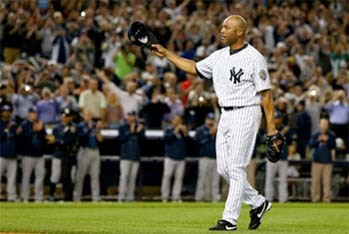 Game and Yankee Stadium were eagerly anticipated as a chance to salute the superstar savior's storied career. Directing those games for television were two of New York's finest:
Game and Yankee Stadium were eagerly anticipated as a chance to salute the superstar savior's storied career. Directing those games for television were two of New York's finest:
FOX Sports' Bill Webb, who also directs games for the Mets, had a home field advantage with this year's All-Star Game held at New York's Citi Field on July 16. Rivera's show-stopping entrance in that Midsummer Classic was a moving warm up for his emotional exit at Yankee Stadium on September 27. That game, directed by John Moore, who helms Yankee games for the YES Network, would become an instant classic. With Rivera in the spotlight at both games, the stage was set:
![]() "This is a night that will not come and go without the New York crowd being able to salute the greatest to ever do his job, Mariano Rivera."
"This is a night that will not come and go without the New York crowd being able to salute the greatest to ever do his job, Mariano Rivera."
- Joe Buck, All-Star Game sportscaster, FOX Sports
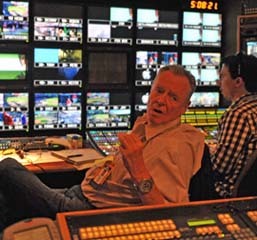 Before every MLB telecast, directors and their production teams go over potential game stories. Then as the action unfolds, the camera follows as new stories emerge. According to Bill Webb, the All-Star Game's biggest storyline was a given from the get-go. "Baseball came to us and said it's Mariano's last year so we want to do something special and if we're lucky, the players will come out of the dugout and shake his hand."
Before every MLB telecast, directors and their production teams go over potential game stories. Then as the action unfolds, the camera follows as new stories emerge. According to Bill Webb, the All-Star Game's biggest storyline was a given from the get-go. "Baseball came to us and said it's Mariano's last year so we want to do something special and if we're lucky, the players will come out of the dugout and shake his hand."
With his chiseled cheekbones, dazzling smile and dignified demeanor, Rivera makes a perfect TV leading man. But what's a director to do when the show's star attraction doesn't appear until the final reel? While clips of Rivera's pre-game locker room pep-talk and career highlights were played in the early innings, Webb's crew was playing Where's Mariano? "All my camera guys know I'm looking for him," says Webb, "so they're telling me on my headset, 'he just came into the dugout' or 'he's inside.' Then all of a sudden, he was in the bullpen." Rivera had made the trek during a commercial so, when the break was over, Webb showed a replay of Rivera walking to the bullpen from the low third dugout camera.
Shooting the All-Star Game has other unique responsibilities. "It's a continuing revolving door of stars who are going to be playing, are playing, or have played, so you're trying to 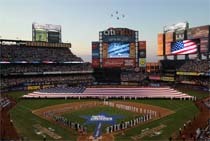 keep up with that flow of information for the people watching." For Webb, that means a lot of juggling. "You have to know the roster. There are all these stats coming down the line and we're cutting to side shots of players in the dugouts." All of these things are in service of the action on the field: "You never lose continuity with the game, because the game is the most important thing."
keep up with that flow of information for the people watching." For Webb, that means a lot of juggling. "You have to know the roster. There are all these stats coming down the line and we're cutting to side shots of players in the dugouts." All of these things are in service of the action on the field: "You never lose continuity with the game, because the game is the most important thing."
Capturing all that action is no small feat. "If you're doing the All-Star Game or postseason, you can't afford to miss a thing," says Webb, "so essentially, you're doubling up to cover the whole field." That means an impressive 24 cameras: eight in the outfield, twelve in the infield, and four robotic cameras (two for each dugout). Each camera has a monitor in the production truck where Webb scans the feeds, making snap decisions about which shots to use, sometimes in seconds. Also in the truck are his producer and their associates, all on headsets to communicate with the crew on the field and announcers in the booth. In addition, as many as 25 tape machines are ready to roll prepared video packages and replays.
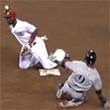 "We have a flow-sheet and video on each player so that if something dramatic happens, we can bookend it with something that happened earlier in the season," says Webb. The preparation paid off when the Reds' Brandon Phillips, who FOX Sports analyst Tim McCarver had called "one of the best second baseman defensively I've ever seen,"
"We have a flow-sheet and video on each player so that if something dramatic happens, we can bookend it with something that happened earlier in the season," says Webb. The preparation paid off when the Reds' Brandon Phillips, who FOX Sports analyst Tim McCarver had called "one of the best second baseman defensively I've ever seen," 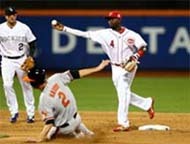 made a routine play. A thrilling clip from earlier in the year was then played, showing a nationwide audience who may not be as familiar with the gold-glover's gifts, what McCarver was talking about. Immediately following it, as if for emphasis, Phillips turned a similarly spectacular double play live, astounding even McCarver ("You gotta love it! Another barehanded double play - What?!") "That was just beautiful," says Webb, who calls the fortuitously timed clip-topper "icing on the cake."
made a routine play. A thrilling clip from earlier in the year was then played, showing a nationwide audience who may not be as familiar with the gold-glover's gifts, what McCarver was talking about. Immediately following it, as if for emphasis, Phillips turned a similarly spectacular double play live, astounding even McCarver ("You gotta love it! Another barehanded double play - What?!") "That was just beautiful," says Webb, who calls the fortuitously timed clip-topper "icing on the cake."
Meanwhile, threaded through the innings were shots of Mariano chatting...Mariano stretching...Mariano clapping. That last cameo came after a scintillating shot sequence of  Tiger slugger Prince Fielder's triple: Fielder hitting - the flare dropping in right field - Fielder hulking around second - the ball relayed in - Fielder sliding headfirst into third, rising to his knees with a victorious "Oh!," as the camera lens zoomed in. The opposing movements gave viewers the impression that Fielder was sliding straight through their TV screens into their laps. That kind of finishing touch by intuitive camera operators makes Webb's job easier: "Imagine if I had to teach that in the middle of calling all those shots."
Tiger slugger Prince Fielder's triple: Fielder hitting - the flare dropping in right field - Fielder hulking around second - the ball relayed in - Fielder sliding headfirst into third, rising to his knees with a victorious "Oh!," as the camera lens zoomed in. The opposing movements gave viewers the impression that Fielder was sliding straight through their TV screens into their laps. That kind of finishing touch by intuitive camera operators makes Webb's job easier: "Imagine if I had to teach that in the middle of calling all those shots."
It's a good thing he didn't have to. As the first guitar strains of Metallica's "Enter Sandman" finally played, summoning Rivera to the field, Webb's team was in position. "We all knew it was going to be a special moment. We just didn't want to screw it up." When Rivera made 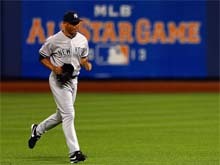 his final warm-up pitch and left the bullpen to take the field, Webb stayed with an RF (radio frequency handheld cable-free) camera, shooting Rivera from behind with his number 42 receding as he ran out. "The symbolism of the shot was that this is his last year and he's going away," says Webb. "Then I cut to a head-on camera by second base of him running in. I also had cable handhelds to get the players and used tracking shots going up the dugouts."
his final warm-up pitch and left the bullpen to take the field, Webb stayed with an RF (radio frequency handheld cable-free) camera, shooting Rivera from behind with his number 42 receding as he ran out. "The symbolism of the shot was that this is his last year and he's going away," says Webb. "Then I cut to a head-on camera by second base of him running in. I also had cable handhelds to get the players and used tracking shots going up the dugouts."
As All-Stars jumped dugout railings to join the ovation, Webb waited. 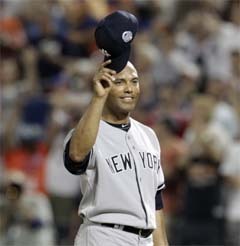 "It would have taken just one player to walk out to the mound and shake his hand. That was what I was praying for, but it never happened." But while MLB's wished-for scene of Mariano surrounded by All-Stars didn't materialize, another touching visual emerged. As an increasingly moved Rivera waved his cap around the field, he indeed seemed surrounded by the appreciation emanating from his applauding admirers. The awe-inspiring scene was summed up by FOX Sports announcer Joe Buck: "In a packed stadium in an All-Star Game, Mariano Rivera was out on that field all alone. It's his spotlight...The best in the business when we come back."
"It would have taken just one player to walk out to the mound and shake his hand. That was what I was praying for, but it never happened." But while MLB's wished-for scene of Mariano surrounded by All-Stars didn't materialize, another touching visual emerged. As an increasingly moved Rivera waved his cap around the field, he indeed seemed surrounded by the appreciation emanating from his applauding admirers. The awe-inspiring scene was summed up by FOX Sports announcer Joe Buck: "In a packed stadium in an All-Star Game, Mariano Rivera was out on that field all alone. It's his spotlight...The best in the business when we come back."
What viewers saw when the telecast returned was a three-up/three-down inning, 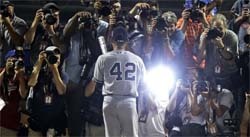 typical of Rivera. "It all worked out famously," says Webb, who finally got to show Rivera being hugged by All-Stars in replays of his triumphant return to the dugout before winning the MVP Award. Along the way, one of FOX's informative graphics reminded fans that current Yankee manager and former batterymate Joe Girardi had caught Rivera's first Major League save. Anyone paying attention to that tidbit of trivia would see it come full circle in Rivera's last game.
typical of Rivera. "It all worked out famously," says Webb, who finally got to show Rivera being hugged by All-Stars in replays of his triumphant return to the dugout before winning the MVP Award. Along the way, one of FOX's informative graphics reminded fans that current Yankee manager and former batterymate Joe Girardi had caught Rivera's first Major League save. Anyone paying attention to that tidbit of trivia would see it come full circle in Rivera's last game.
![]() "We were like 'whoa - what?' We had no idea that was gonna happen. We just assumed he was going to finish the game."
"We were like 'whoa - what?' We had no idea that was gonna happen. We just assumed he was going to finish the game."
- John Moore, Yankee games director, YES Network
As the exquisite prima ballerina Margot Fonteyn danced her farewell performance in 1979, the audience at London's Royal Opera House was moved to tears when her famed choreographer Fredrick Ashton unexpectedly appeared and, beckoning to the wings, led her off into legend. Only the greatest get that kind of escort, and Mariano Rivera is one of the all-time greats.
 "I've always maintained it's not just about directing and it's not just about camera shots. The whole thing is a puzzle," says John Moore who directed Rivera's farewell performance. It too would feature a dazzling dance of technique and emotion with a climactic surprise appearance. Fortunately, most of Moore's regular crew was with him: "It's almost like we practiced for years for this moment. So many historic things have happened at Yankee Stadium that there's a heightened awareness that anything could happen there," says Moore. "It makes for great TV and the feeling of great drama."
"I've always maintained it's not just about directing and it's not just about camera shots. The whole thing is a puzzle," says John Moore who directed Rivera's farewell performance. It too would feature a dazzling dance of technique and emotion with a climactic surprise appearance. Fortunately, most of Moore's regular crew was with him: "It's almost like we practiced for years for this moment. So many historic things have happened at Yankee Stadium that there's a heightened awareness that anything could happen there," says Moore. "It makes for great TV and the feeling of great drama."
With the Yankees out of postseason contention and a slew of superstar injuries, fans had little to celebrate in their final home game. Saying goodbye to Rivera was the only thing on the agenda. Still, Moore was careful: "I wanted to make sure we didn't just hit it from the first pitch because you have the danger of overselling the moment as opposed to just letting the moment happen." But that moment was hours away. "With each passing inning the anticipation of Mariano coming into the game is growing, but there's no Mariano to shoot," says Moore. "It's almost like waiting to see a movie star, rock star or president where you say 'oh wait, there he is,' which for this particular game really heightened the suspense."
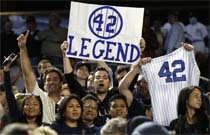 Feeding that feeling were the crowd's intermittent chants of "Ma-ri-a-no!" and "We want Mo!" which Moore peppered with shots of fan-made signs. One of the best, "I want to thank the Good Lord for making 'Mo' a Yankee" changed a single letter in Joe DiMaggio's quote to assert Rivera's honored place in his historic franchise. But for the most part, Moore focused on the field: "My feeling is that people pay to see the players, not the fans. They're part of it, but you have to be so careful to not make them the story." But sometimes, the fans make themselves the story.
Feeding that feeling were the crowd's intermittent chants of "Ma-ri-a-no!" and "We want Mo!" which Moore peppered with shots of fan-made signs. One of the best, "I want to thank the Good Lord for making 'Mo' a Yankee" changed a single letter in Joe DiMaggio's quote to assert Rivera's honored place in his historic franchise. But for the most part, Moore focused on the field: "My feeling is that people pay to see the players, not the fans. They're part of it, but you have to be so careful to not make them the story." But sometimes, the fans make themselves the story.
By the time Rivera got up in the eighth, the buzz that had been building in the stands became a spectacle as fans were seen with their backs to the field, standing on seats, facing the bullpen. "I think the coolest thing is people started to not even watch the game other than to see if the pitcher was going to get knocked out," recalls Moore. "It was just an amazing sight." It was also a surreal one as close ups of fan-held phones captured Rivera warming up on multiple mini-screens. Over another close up of a wide-eyed little boy, YES Network announcer Michael Kay simply said, "Remember this, kid." The images that were about to follow would be unforgettable.
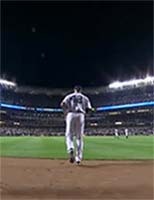 As Rivera was announced and his "Enter Sandman" theme began, a bullpen camera smoothly caught Rivera walking forward, below, and away in one shot. A cut to a low camera seamlessly picked up Rivera from behind, heading through the narrow bullpen exit and trotting to the vast field of cheering fans and flashing lights beyond. With a subtle dissolve worthy of a major Hollywood movie, another camera picked up Rivera's running feet, then tilted up to his face, fusing the scene with gravitas. Long shots showed standing bullpens and visiting Rays players applauding. Close ups were reserved for Rivera and teammates Andy Pettitte and Derek Jeter who had all made the majors together. Only Girardi knew what role they would soon play as he punctuated the momentous moment by portentously handing Rivera the ball.
As Rivera was announced and his "Enter Sandman" theme began, a bullpen camera smoothly caught Rivera walking forward, below, and away in one shot. A cut to a low camera seamlessly picked up Rivera from behind, heading through the narrow bullpen exit and trotting to the vast field of cheering fans and flashing lights beyond. With a subtle dissolve worthy of a major Hollywood movie, another camera picked up Rivera's running feet, then tilted up to his face, fusing the scene with gravitas. Long shots showed standing bullpens and visiting Rays players applauding. Close ups were reserved for Rivera and teammates Andy Pettitte and Derek Jeter who had all made the majors together. Only Girardi knew what role they would soon play as he punctuated the momentous moment by portentously handing Rivera the ball.
"Once Mariano got into the game I made a conscious decision to stay out of the stands," recalls Moore, who opted instead for impressive tableaux of Rivera framed in the foreground like a shining star before a background constellation of devoted fans. "I always try, whether it's covering a game or a moment, to do balanced shooting so that you see 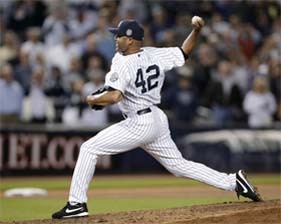 close ups, but also get wide shots where everyone's on the field in relation to each other," explains Moore. "I'll usually have to call 'perspective' or 'go in tight' so that I can balance out what everyone is shooting."
close ups, but also get wide shots where everyone's on the field in relation to each other," explains Moore. "I'll usually have to call 'perspective' or 'go in tight' so that I can balance out what everyone is shooting."
One stunning shot followed Rivera, his glove with his name on it held high, dipping down into his windup, looking like a signed baseball card come to life. The shot, immortalized in memory, becomes a sort of cinematic collector's item, one that grows more valuable with age. Just as they did over that shot, Moore points out "the announcers talk all the time about how one of the things that makes Mariano so good is that he repeats his delivery flawlessly. That's heaven for us because we know exactly how he's going to move because he does it consistently every time."
Getting batters out is something Rivera does consistently as well. With two down in the ninth, Kay prepared viewers: "Mo has one more out to get in the Bronx." That's when the 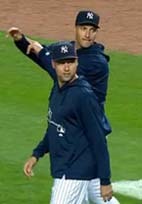 plot twisted. A cutaway from Rivera's heavy-hearted expression revealed the anomalous sight of Pettitte and Jeter coming out to the mound. As Pettitte signaled for a pitching change, a stunned Kay asked TV viewers "How's this for drama?"
plot twisted. A cutaway from Rivera's heavy-hearted expression revealed the anomalous sight of Pettitte and Jeter coming out to the mound. As Pettitte signaled for a pitching change, a stunned Kay asked TV viewers "How's this for drama?"
"That caught us off guard," says Moore who was as surprised as Rivera. But while ecstatic fans savored the significance, Moore faced a challenge: "What's going through my mind is 'oh boy, I've got a facial conflict here.' You've got two guys walking towards the other guy and you can only see the faces of either him or them. So I took a shot of them coming out of the dugout to establish what was happening and then cut back and stayed with Mariano because he's the story."
But as Rivera sobbed in Pettitte's embrace, Moore was forced to move. "I cut behind him for the hug because you couldn't see his face anymore." When he finally resurfaced to hug 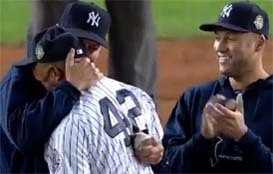 Jeter, Moore caught a close up of Rivera, shedding a tear. He wasn't the only one. "My eyes were welling up and fortunately there weren't a lot of places to go (shot-wise) because I was having a hard time speaking," says Moore. "It was as incredible a moment as I think I've ever seen and when you associate with the Yankees, you see a lot."
Jeter, Moore caught a close up of Rivera, shedding a tear. He wasn't the only one. "My eyes were welling up and fortunately there weren't a lot of places to go (shot-wise) because I was having a hard time speaking," says Moore. "It was as incredible a moment as I think I've ever seen and when you associate with the Yankees, you see a lot."
But even directors can't see everything. "I always have this fear of cutting off something great, or cutting to the wrong thing so you're missing something important," says Moore. To rescue those lost moments, tape operators monitor everything that's recorded. Luckily, one of them reviewing the reverse shot of Pettitte and Jeter approaching the mound could read lips. Recalls Moore, "My producer (on headset) got in Michael Kay's ear and told him 'check this out, you're going to see Jeter saying 'time to go' to Rivera.'" Later, Kay relayed Jeter's words over a slow motion replay that let TV viewers read Jeter's lips for themselves. For Moore, it's all about priorities: "I always hope to get the best thing live because you only get live once."
Eventually, Rivera left the mound, wiping his eyes and doffing his cap to thunderous 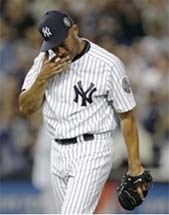 applause. He was met in front of the dugout by Girardi. But before he could descend the steps, Rivera dropped his game ball. Girardi picked it up and placed it back in Rivera's glove, as he must have done years ago after Rivera's first save. Rivera would go on to hug his way through the dugout, emerging out the other end for an extended curtain call, weeping and waving to a grateful throng, awash in adoration. By then, anyone who wasn't crying can't make tears.
applause. He was met in front of the dugout by Girardi. But before he could descend the steps, Rivera dropped his game ball. Girardi picked it up and placed it back in Rivera's glove, as he must have done years ago after Rivera's first save. Rivera would go on to hug his way through the dugout, emerging out the other end for an extended curtain call, weeping and waving to a grateful throng, awash in adoration. By then, anyone who wasn't crying can't make tears.
"To watch it all unfold, I could barely talk when we saw the tears going down his face," recalls Moore, still moved by the heart-stopping scene. "We're very fortunate it played out fairly flawlessly." That is, until the game ended and the traditional playing of Frank Sinatra's rendition of "New York, New York" sounded. While players left the field and dugout, Rivera lingered, alone on the bench. "I couldn't get a nice close up. You don't want to get blocked by people, but it happens all the time. It's very frustrating," says Moore. "The only shot I had was from the near-end dugout, but it was a dramatic look, in that you could see all the photographers surrounding him."
When Rivera headed back out to the field to more cheers, the swarm of cameras followed. As if on cue, just as Sinatra sang the words "king of the 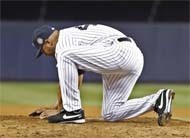 hill," Rivera reached the mound where he scooped up some dirt, taking a handful of his spotlight with him. Five years from now, a bronze plaque in the Baseball Hall of Fame will boast of the Yankee closer who rode a cutter to Cooperstown, accumulating an all-time record 652 saves with a fitting 42 saves in the postseason. "He's the biggest security blanket in all of sports," said YES Network analyst, Ken Singleton. "Thank you is not enough."
hill," Rivera reached the mound where he scooped up some dirt, taking a handful of his spotlight with him. Five years from now, a bronze plaque in the Baseball Hall of Fame will boast of the Yankee closer who rode a cutter to Cooperstown, accumulating an all-time record 652 saves with a fitting 42 saves in the postseason. "He's the biggest security blanket in all of sports," said YES Network analyst, Ken Singleton. "Thank you is not enough."
When Rivera finally headed for the dugout tunnel, Moore looked for a last shot. "As it was happening, I was saying out loud 'how great would it be if the guard closed the door,' so one of our camera guys yelled to him 'close the door!' and he did." The shot, repeated in slow motion to end the broadcast, showed Rivera disappearing from view as the doors closed on his 19-year career. Says Moore: "You couldn't have scripted it better." While the Yankees finished their season on the road, Rivera did not play again, calling his final Yankee Stadium appearance "perfect," insisting, "I left it all on the field."
Moore feels the same way. "I can't believe if I go back and look at other moments that I'll find anything that tops it. It's something that I'll always remember as one of the highlights 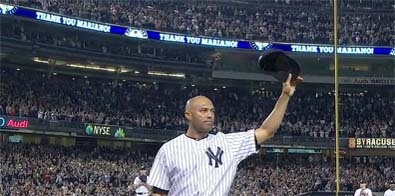 of my career." Those highlights of Rivera's Yankee Stadium exit, like his All-Star Game entrance, will be replayed as long as baseball lives. "This would have been one that would have crushed me to not be a part of," says Moore. "You knew it was going to be special, but you didn't know how special, and after the fact you go, 'wow, thank God, I was here.'" Thanks to the creative vision of these directors, so were we.
of my career." Those highlights of Rivera's Yankee Stadium exit, like his All-Star Game entrance, will be replayed as long as baseball lives. "This would have been one that would have crushed me to not be a part of," says Moore. "You knew it was going to be special, but you didn't know how special, and after the fact you go, 'wow, thank God, I was here.'" Thanks to the creative vision of these directors, so were we.
Up next in Shooting Diamonds: Directing the World Series. On deck in Shooting Diamonds: Directing the No-Hitter.
 Get tips on how to watch a game on TV from MLB's best announcers here. For the MLB All-Star Game's greatest moments, go here. To read about Joe DiMaggio, Ted Williams and the All-Star Game of '41, go here. For more Superheroes of Baseball, go here. For a look at another historic Yankee game, go here. For more on the author, visit www.devramaza.com.
Get tips on how to watch a game on TV from MLB's best announcers here. For the MLB All-Star Game's greatest moments, go here. To read about Joe DiMaggio, Ted Williams and the All-Star Game of '41, go here. For more Superheroes of Baseball, go here. For a look at another historic Yankee game, go here. For more on the author, visit www.devramaza.com.
Photo credits: Bill Webb courtesy of FOX Sports; John Moore courtesy of YES Network; Rivera and Rays, ASG pre-game ceremony, Phillips double plays, Rivera enters ASG, Citi Field, commemorative base courtesy of Getty Images; Rivera waves cap, Rivera weeps courtesy of Reuters; Rivera exits bullpen, Fielder slides, MVP Rivera faces photographers, Yankee fans, Rivera runs in, Rivera pitching, Pettitte and Jeter, Rivera hugs Pettitte with Jeter, Rivera walks off, Rivera saves dirt, Rivera's curtain call courtesy of AP.
![]() Baseball's best: What's your favorite TV moment from the 2013 MLB season? Tell us in Comments.
Baseball's best: What's your favorite TV moment from the 2013 MLB season? Tell us in Comments.
